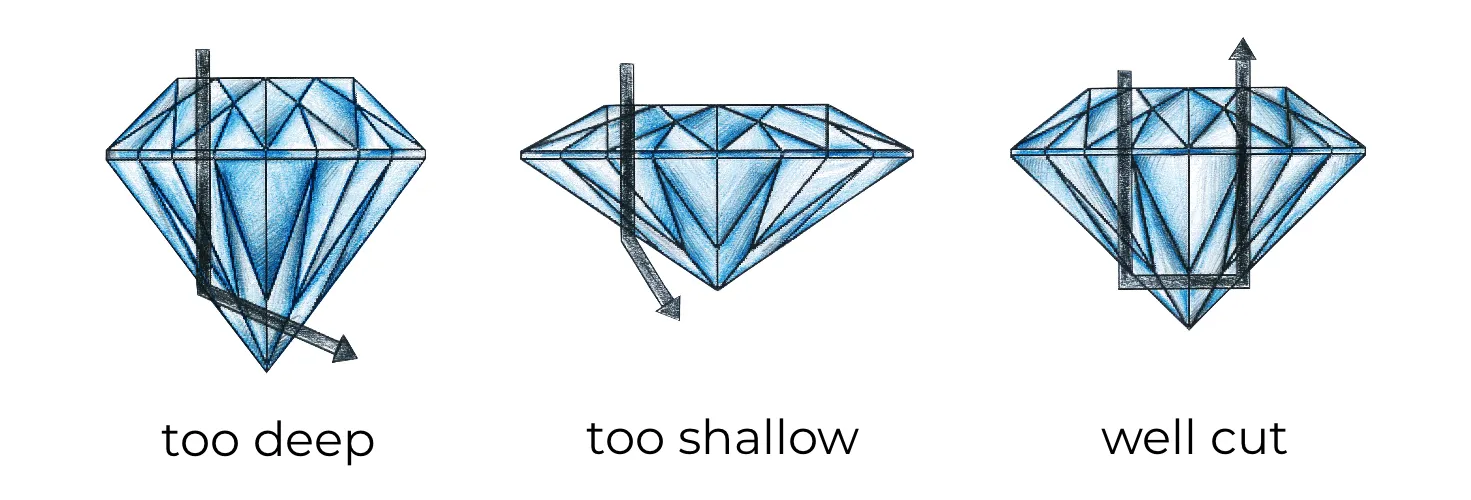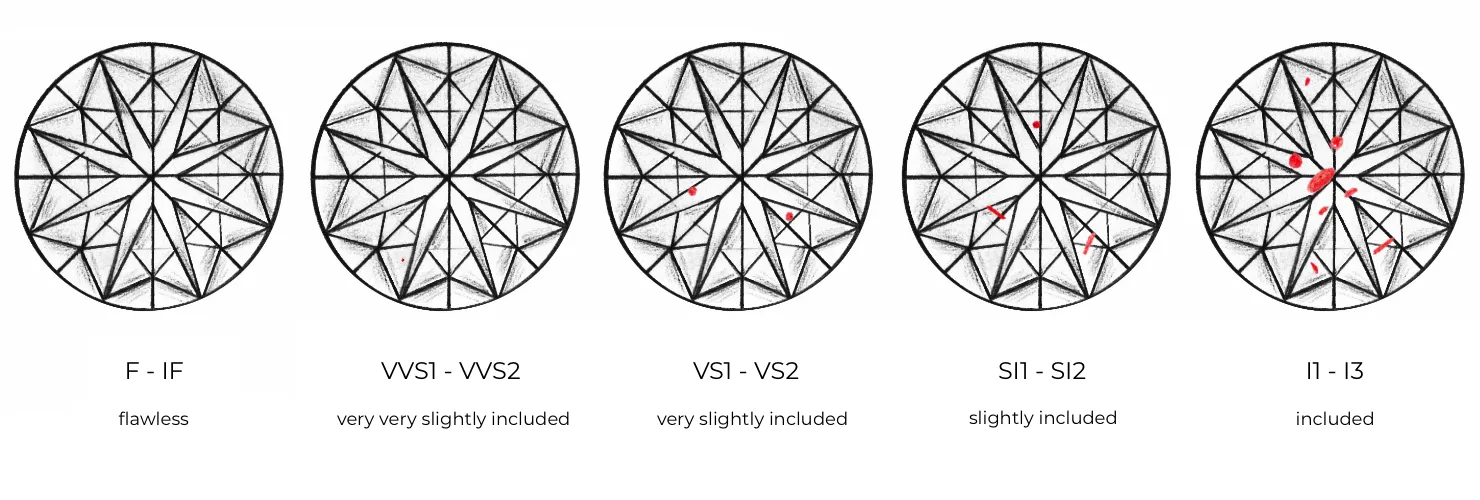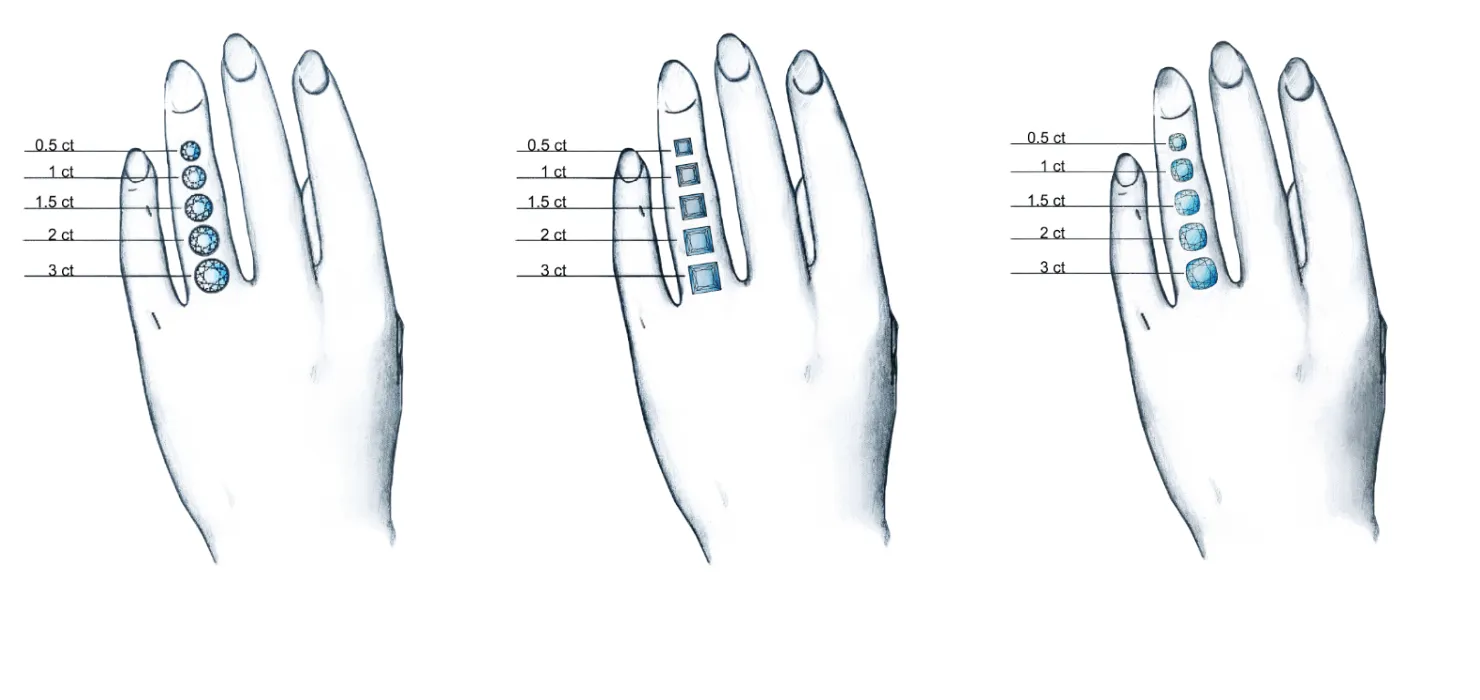GRADING

Diamond color is a Fancy Colored Diamond’s most significant characteristic. In fact, unlike a colorless diamond where the 4C's (carat weight, clarity, color, and cut) are all equally important to the overall value, the color characteristic plays the most important role in the value of the diamond. With white diamonds the absence of color is what makes the diamonds so precious. However, in the case of fancy colored diamonds, the presence of color and the intensity of how it shines is specifically what increase the value of the stones.
First off, lets start with the basics. Most of you probably already know that there is a scale of diamond color from D to Z. D, of course, is completely colorless while Z is heavily tinted with yellow. But all along that scale from D to Z, the discussion is still about what are categorized as “white diamonds.” A Z color diamond is a heavily yellow tinted white diamond. The world of diamonds, though, is not limited to this scale. Diamonds falling off this scale are commonly called “Fancy Color Diamonds” or “Fancy Diamonds.” What Diamonds Are Considered “Fancy Color Diamonds”? Diamonds can either fall off this scale because they’re tinted with a shade other than yellow, or because the yellow color inside the diamond is so strong that the diamond is no longer considered a tinted white diamond, but rather a full fledged yellow diamond. Diamonds can come in a variety of colors. The chart below (from Page 12 of “Forever Brilliant: The Aurora Collection of Colored Diamonds”) is an excellent graphical display of the variety of colors in which diamonds can be found.
History of Visible and Arrows
Hearts and Arrows Viewer Modern, portable H&A viewers The hearts and arrows pattern was first viewed using a Firescope; a tool developed by Kazumi Okuda in the 1970s. Firescopes and their modern equivalents (such as the H&A Viewer, Ideal-scope and ASET-scope) use colored reflectors to display a pattern showing the direction and intensity of light emitted from a diamond. These colorful patterns can be evaluated to determine how much light is exiting the diamond at proper angles, and whether the diamond is optically symmetrical (indicated by a uniform pattern).

CUT

The way a diamond is cut is the most important thing that makes it shine and sparkle. Cutting a diamond is a special skill that takes a lot of practice and care. The better the cut, the more a diamond will sparkle and catch the light. This sparkle is called "brilliance," and the flashes of rainbow colors are called "fire." When you're choosing a diamond, you want one that's cut perfectly so it can show off all its sparkle and fire!
COLOR

Diamonds are traditionally valued for their lack of color. The Gemological Institute of America (GIA) uses a color scale ranging from D (colorless) to Z (light yellow). Colorless diamonds command a premium price, but fancy colored diamonds, like yellows, pinks, and blues, are becoming increasingly popular. These rare beauties offer a unique personality and add a touch of undeniable sophistication to any piece. Ultimately, the color you choose depends on your personal preference and budget.
CLARITY

Almost all diamonds have tiny imperfections called inclusions. These can be internal (within the diamond) or external (on the surface). The size, location, and number of inclusions affect the clarity grade and, consequently, the diamond's price. You can choose a stone that is virtually flawless to the naked eye or you can choose a diamond with slight inclusions, visible only under magnification, that still delivers stunning beauty and remarkable value - the choice is yours!
CARAT

We've all heard the phrase "bigger is better," but when it comes to diamonds, carat weight is just one piece of the puzzle. Carat refers to the weight of a diamond, with one carat equaling 0.2 grams. While a larger diamond will naturally appear bigger, other factors like cut and shape can significantly impact a diamond's perceived size. Imagine two diamonds – one round and one oval – with the same carat weight. The oval diamond will likely appear larger due to its elongated shape. Understanding carat weight is important, but it's just the first step in finding the perfect diamond for your needs and budget.
A diamond certificate, issued by a reputable gemological institute like the Gemological Institute of America (GIA) or the International Gemological Institute (IGI), is a document that details a diamond's specific characteristics. This includes its carat weight, cut grade, color grade, clarity grade, and any other significant features. Think of it as a diamond's passport, verifying its authenticity and quality. While all certificates provide valuable information, understanding the differences between grading institutions is important. Each institute may have slight variations in their grading scales, so a GIA-graded "H" color diamond might appear slightly different from an IGI-graded "H" color diamond.
Let Us Help You Find Your Perfect Diamond
Choosing a diamond is a significant decision, and we understand the importance of getting it right.
With our extensive knowledge, vast selection, and commitment to ethical sourcing, Shree Krishna Exports is your trusted partner in finding the perfect diamond that embodies love, beauty, and lasting brilliance.
Let us guide you on this exciting journey and help you discover a diamond that will speak to you.
CARAT WEIGHT
| Size Range 0.30 up |
CLARITY
| FL, IF, VVS1, VVS2, VS1, VS2, SI1, SI2, SI3, I1, I2, I3 |
COLOR
| D, E, F, G, H, I, J, K, L, M, N, O-P, Q-R, W-X, Y-Z |
CUT
| # | Cut Grades | Description |
|---|---|---|
| 1 | EX | Excellent |
| 2 | VG | Very Good |
| 3 | GD | Good |
| 4 | F | Fair |
POLISH
| # | Polish | Description |
|---|---|---|
| 1 | EX | Excellent |
| 2 | VG | Very Good |
| 3 | GD | Good |
| 4 | F | Fair |
SYMMETRY
| # | Symmetry Grades | Description |
|---|---|---|
| 1 | EX | Excellent |
| 2 | VG | Very Good |
| 3 | GD | Good |
| 4 | F | Fair |
WHITE INCLUSION BASE
| # | Grade | Description |
|---|---|---|
| 1 | N | None |
| 2 | TCR01/SCR01 | Table/Side Minor Crystal |
| 3 | TCR1/SCR1 | Table/Side Crystal Small |
| 4 | TCR2/SCR2 | Table/Side Crystal Medium |
| 5 | TCR3/SCR3 | Table/Side Crystal Heavy |
| 6 | TF01/SF01 | Table/Side Minor Feather |
| 7 | TF1/SF1 | Table/Side Feather Minor |
| 8 | TF2/SF2 | Table/Side Feather Medium |
| 9 | TF3/SF3 | Table/Side Feather Heavy |
| 10 | TCL01/SCL01 | Table/Side Minor Cloud |
| 11 | TCL1/SCL1 | Table/Side Cloud Minor |
| 12 | TCL2/SCL2 | Table/Side Cloud Medium |
| 13 | TCL3/SCL3 | Table/Side Cloud Heavy |
BLACK INCLUSION BASE
| # | Grade | Description |
|---|---|---|
| 1 | N | None |
| 2 | TB01/SB01 | Table/Side Minor Black |
| 3 | TB1/SB1 | Table/Side Small Black |
| 4 | TB2/SB2 | Table/Side Medium Black |
| 5 | TB3/SB3 | Table/Side Heavy Black |
OPEN BASE
| # | Grade | Description |
|---|---|---|
| 1 | N | None |
| 2 | TO01/SO01 | Table/Side Minor Open |
| 3 | TO1/SO1 | Table/Side Small Open |
| 4 | TO2/SO2 | Table/Side Medium Open |
| 5 | TO3/SO3 | Table/Side Heavy Open |
| 6 | NT01/NS01 | Natural Table/Side Minor |
| 7 | NT1/NS1 | Natural Table/Side Small |
| 8 | NT2/NS2 | Natural Table/Side Medium |
| 9 | NT3/NS3 | Natural Table/Side Heavy |
| 10 | TCV01/SCV01 | Table/Side Minor Cavity |
| 11 | TCV1/SCV1 | Table/Side Small Cavity |
| 12 | TCV2/SCV2 | Table/Side Medium Cavity |
| 13 | TCV3/SCV3 | Table/Side Heavy Cavity |
FLUORESCENCE
| # | FL Grades | Parameters |
|---|---|---|
| 1 | N | None Fluorescence |
| 2 | FNT | Faint Fluorescence |
| 3 | MED | Medium Fluorescence |
| 4 | STG | Strong Fluorescence |
| 5 | VST | Very Strong Fluorescence |
COLOR SHADE
| # | Grade | Color Shade | Color Shade Description |
|---|---|---|---|
| 1 | N | None | None |
| 2 | B1/G1/MT1 | Brown/Green/Mix | Light Tinge |
| 3 | B2 | Brown/Green/Mix | Medium Tinge |
| 4 | B3 | Brown/Green/Mix | Heavy Tinge |
MILKY
| # | Grade | Size/Description |
|---|---|---|
| 1 | N | None |
| 2 | M1 | Light |
| 3 | M2 | Medium |
| 4 | M3 | Heavy |
EYECLEAN
| # | Grade | Description |
|---|---|---|
| 1 | No | None |
| 2 | Yes | 100% |
| 3 | Borderline | 80%-90% |
| 4 | E1 | 60%-70% |
| 5 | E2 | 50% |
HEART & ARROW BASE
| # | Grade | Description |
|---|---|---|
| 1 | EX | Ex H%A |
| 2 | VG | VG H%A |
| 3 | NV | None Visible |
ROUGH ORIGIN
| # | Grade | Description |
|---|---|---|
| 1 | CM | Canada Mark |
| 2 | CME | Canada Mark Eligible |
| 3 | FM | Forever Mark |
| 4 | FMG | Forever Mark Grading |
| 5 | FME | Forever Mark |
| 6 | FMI | Forever Mark Inscribed |
LAB
| # | Lab | Description |
|---|---|---|
| 1 | GIA | Gemological Institute of America |
| 2 | IGI | International Gemological Institute |
| 3 | HRD | Hoge Raad voor Diamand |
NEW ARRIVALS DATE
| This is the date on which new goods transfer for sale. |


Brillant Round
Radiating timeless elegance, the round cut diamond dazzles with its brilliance, adding a touch of sophistication to any hand.
Oval
Offering a touch of modern flair, the oval cut elongates the finger and creates a dazzling display of light.
Marquise
With its elongated and pointed ends, the marquise cut exudes a sense of sophisticated glamour.
Pear
Combining the brilliance of a round cut with a touch of whimsy, the pear-shaped diamond adds a touch of individuality.
Heart
A symbol of love and devotion, the heart-shaped diamond is perfect for a romantic gesture.
Princess
Princess cut diamonds boast modern elegance with their clean lines and remarkable sparkle.
Asscher
This beautifully unique shape is nearly identical to the emerald-cut, except that it is square.
Emerald
Known for its rectangular shape with cropped corners, the emerald cut offers a distinctive and elegant look.
Radiant
Offering a captivating blend of square and round cuts, the radiant diamond delivers brilliance and a contemporary feel.
Cushion
With its soft, rounded corners, the cushion cut exudes a timeless and romantic charm.